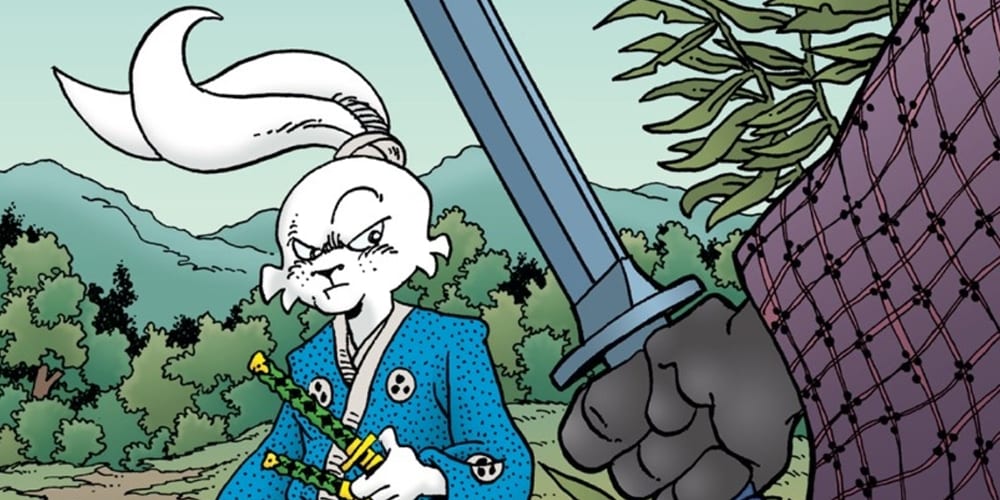Stan Sakai’s classic Rabbit Rōnin, Miyamoto Usagi, receives the IDW Color Classics treatment in this week’s Usagi Yojimbo Color Classics #1.
Sakai’s Usagi has been around since 1984, appearing in his own titular series and many others. To catch up on the 36 years of Rabbit Rōnin adventures, take a gander at the Wikipedia page. Plus check out our review for the first issue of the newest full-color IDW series.

USAGI YOJIMBO’S CLASSIC STORY
Usagi Yojimbo Color Classics #1 (Usagi Yojimbo CC #1 from here out) is a reprint of Sakai’s classic first issue from 1986, but in color. One amazing factor of Sakai’s classic is how 30 years later the story is still relatable, giving it a timeless factor. Sakai’s story begins with Usagi dueling another who has betrayed his Lord, Mifune. Once said duel is over in a few beautiful pages, Sakai introduces the Bounty Hunter Gen as a plot device to tell Usagi’s history. In this flashback, Usagi regales Gen (and the reader) with his training to become a Samurai.
Usagi Yojimbo CC #1 reads like most Samurai tales, yet there is a certain charm that makes you love it. It may be over 30 years old, but the humor, pace, story structure, and verbiage stand the test of time. Yes, there may be a little blood (more pronounced due to color), but Usagi Yojimbo #1 retains an all-ages vibe. Yet, as an adult, you can equally enjoy every factor of the storytelling.
Usagi Yojimbo has been a creator-owned series for years with Sakai pulling triple duty as Writer, Artist, and (multiple Eisner-winning) Letterer throughout most of it. This trifecta of hands-on everything works perfectly for his tale as he knows exactly where to place dialogue bubbles. There are a few moments immensely heavy in dialogue, yet Sakai makes sure the letters never take over the art.

USAGI YOJIMBO FUNHOUSE
These new Color Classics come with extra behind-the-scenes moments and little side-stories. Usagi Yojimbo CC #1 is bundled with a one-page side story dubbed Funhouse. This singular page is done by Stan Sakai, Julie Sakai, and colorist Emi Fujii. Although it is only one page, Funhouse is adorable and would make a fun series by this team.
ART THAT TRANSCENDS TIME
Reading through Usagi Yojimbo‘s history, Sakai’s art has been constantly great while growing even better. Not much needs to be said that hasn’t been for how amazingly simple, yet beautiful his art is. But, before we move on to the big change in the classic, Usagi Yojimbo‘s opening pages are worth note. During the opening pages, Sakai pits Usagi and Gunichi in a Single Stroke Battle, a fighting method made famous in Samurai films and anime where two skilled warriors run at each other and strike once.
As overdone as this trope can sound, Sakai made it look gorgeous in its execution. Sakai keeps it silent with only a few sound effects and builds up the tension with a few pages. On the final page, Sakai shows the final effect with long rectangle pages that mirrors movies. When the defeated falls, animals watching run away in fear. These few pages are gorgeous in their cinematic likeness.

USAGI YOJIMBO COLOR CLASSIC
The higher focus for the Color Classics is Ronda Pattison’s colors. Pattison’s name is well known to fans of famous anthropomorphic, as she worked on IDW’s TMNT. Although Usagi Yojimbo is great in its original black and white style, Pattison’s colors adds an updated feeling. After its first release 33 years ago, the lively colors Pattison adds brings the world to alluring life.
Between the lush green backdrops, to the bright colors of some of the suits, the colors perfectly blend in. In a time were coloring over classics can outrage fans by changing the overall feel, Pattison does the opposite of that. If anything, her colors bring about a rejuvenation to Sakai’s classic, which will have old fans clamoring to buy it and new fans wanting more.

THE BEGINNING OF A CLASSIC (CONCLUSION)
Sakai’s Usagi Yojimbo is a classic that has received years of praise. Meaning it’s hard not to recommend it, as it’s stood the test of time and stands tall. The difference with the Color Classics is the added color from Pattison. Her colors match the atmosphere of the anthropomorphic world perfectly. At no point do her colors seem too modern or out of place. Instead, the colors feel as if they were there since the beginning.
Fun Fact: I’ve never read Usagi Yojimbo. It has been one I’ve wanted to read as it’s at the local library. After finishing this Color Classics it’s moved up high on the read list. If you haven’t read any of the long-running stories, now’s the best time as ever.
NEW FANS, OLD FANS ALIKE
If you’re a new reader or a classic reader, we’d love to hear what you thought of the classic now in color down below.


